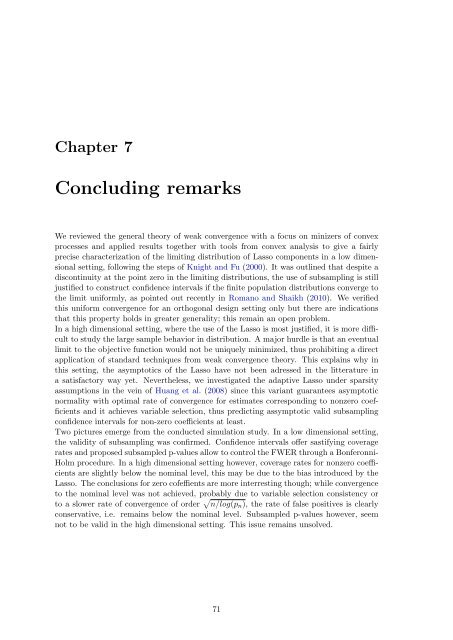Subsampling estimates of the Lasso distribution.
Subsampling estimates of the Lasso distribution.
Subsampling estimates of the Lasso distribution.
Create successful ePaper yourself
Turn your PDF publications into a flip-book with our unique Google optimized e-Paper software.
Chapter 7<br />
Concluding remarks<br />
We reviewed <strong>the</strong> general <strong>the</strong>ory <strong>of</strong> weak convergence with a focus on minizers <strong>of</strong> convex<br />
processes and applied results toge<strong>the</strong>r with tools from convex analysis to give a fairly<br />
precise characterization <strong>of</strong> <strong>the</strong> limiting <strong>distribution</strong> <strong>of</strong> <strong>Lasso</strong> components in a low dimensional<br />
setting, following <strong>the</strong> steps <strong>of</strong> Knight and Fu (2000). It was outlined that despite a<br />
discontinuity at <strong>the</strong> point zero in <strong>the</strong> limiting <strong>distribution</strong>s, <strong>the</strong> use <strong>of</strong> subsampling is still<br />
justified to construct confidence intervals if <strong>the</strong> finite population <strong>distribution</strong>s converge to<br />
<strong>the</strong> limit uniformly, as pointed out recently in Romano and Shaikh (2010). We verified<br />
this uniform convergence for an orthogonal design setting only but <strong>the</strong>re are indications<br />
that this property holds in greater generality; this remain an open problem.<br />
In a high dimensional setting, where <strong>the</strong> use <strong>of</strong> <strong>the</strong> <strong>Lasso</strong> is most justified, it is more difficult<br />
to study <strong>the</strong> large sample behavior in <strong>distribution</strong>. A major hurdle is that an eventual<br />
limit to <strong>the</strong> objective function would not be uniquely minimized, thus prohibiting a direct<br />
application <strong>of</strong> standard techniques from weak convergence <strong>the</strong>ory. This explains why in<br />
this setting, <strong>the</strong> asymptotics <strong>of</strong> <strong>the</strong> <strong>Lasso</strong> have not been adressed in <strong>the</strong> litterature in<br />
a satisfactory way yet. Never<strong>the</strong>less, we investigated <strong>the</strong> adaptive <strong>Lasso</strong> under sparsity<br />
assumptions in <strong>the</strong> vein <strong>of</strong> Huang et al. (2008) since this variant guarantees asymptotic<br />
normality with optimal rate <strong>of</strong> convergence for <strong>estimates</strong> corresponding to nonzero coefficients<br />
and it achieves variable selection, thus predicting assymptotic valid subsampling<br />
confidence intervals for non-zero coefficients at least.<br />
Two pictures emerge from <strong>the</strong> conducted simulation study. In a low dimensional setting,<br />
<strong>the</strong> validity <strong>of</strong> subsampling was confirmed. Confidence intervals <strong>of</strong>fer sastifying coverage<br />
rates and proposed subsampled p-values allow to control <strong>the</strong> FWER through a Bonferonni-<br />
Holm procedure. In a high dimensional setting however, coverage rates for nonzero coefficients<br />
are slightly below <strong>the</strong> nominal level, this may be due to <strong>the</strong> bias introduced by <strong>the</strong><br />
<strong>Lasso</strong>. The conclusions for zero c<strong>of</strong>effients are more interresting though; while convergence<br />
to <strong>the</strong> nominal level was not achieved, probably due to variable selection consistency or<br />
to a slower rate <strong>of</strong> convergence <strong>of</strong> order √ n/log(p n ), <strong>the</strong> rate <strong>of</strong> false positives is clearly<br />
conservative, i.e. remains below <strong>the</strong> nominal level. Subsampled p-values however, seem<br />
not to be valid in <strong>the</strong> high dimensional setting. This issue remains unsolved.<br />
71
















